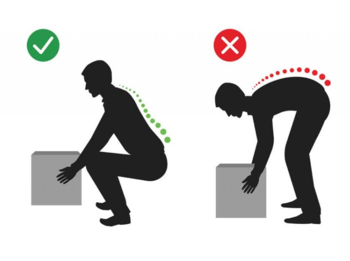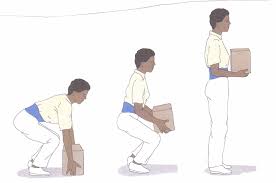Lifting: Difference between revisions
No edit summary |
No edit summary |
||
| Line 32: | Line 32: | ||
* Keep loads as close to the body as possible and do not twist while lifting, carrying, or setting down a load. Nose, shoulders, hips, and toes should all be facing the same direction. | * Keep loads as close to the body as possible and do not twist while lifting, carrying, or setting down a load. Nose, shoulders, hips, and toes should all be facing the same direction. | ||
* Minimize reaching. | * Minimize reaching. | ||
* Stoop or squat if the load is below you and a ladder if it is too high. | * Stoop or squat if the load is below you and use a ladder if it is too high. | ||
* As a general rule, bend at the knees, not the hips. | * As a general rule, bend at the knees, not the hips. | ||
* Get help when needed. | * Get help when needed. | ||
| Line 42: | Line 42: | ||
* Place items to be lifted within the “power zone”. ie close to the body, between the mid-thigh and mid-chest of the person doing the lifting. This is the area where the arms and back can lift the most with the least amount of effort. | * Place items to be lifted within the “power zone”. ie close to the body, between the mid-thigh and mid-chest of the person doing the lifting. This is the area where the arms and back can lift the most with the least amount of effort. | ||
{{#ev:youtube|z4epeIusue0|300}}<ref>Amit G Alon. How To Lift Heavy Weight Safely. Available from: https://www.youtube.com/watch?v=z4epeIusue0 [last accessed 16/4/2022]</ref> | |||
== References == | == References == | ||
Revision as of 19:23, 16 April 2022
Original Editor - The Open Physio project
Top Contributors - Oladayo Babalola, Admin, Rachael Lowe, Lucinda hampton, Kim Jackson, WikiSysop and Niha Mulla
Introduction[edit | edit source]
Many lower back injuries come about as a result of poor lifting techniques, something that physiotherapists are uniquely placed to address.
- Lifting heavy items is one of the leading causes of injury in the workplace.
- Bending, followed by twisting and turning, were the more commonly cited movements that caused back injuries.
- Strains and sprains from lifting loads improperly or from carrying loads that are either too large or too heavy are common hazards associated with manually moving materials.
- When using smart lifting practices, people are less likely to suffer from back sprains, muscle pulls, wrist injuries, elbow injuries, spinal injuries, and other injuries caused by lifting heavy objects[1].
The following principles of safe lifting should be covered whenever you treat a patient with Lower back pain.
Principles of Safe Lifting[edit | edit source]
- Assess the immediate area and load to be lifted.
- Bend the knees to lower the body to the level of the load.
- Keep feet shoulder width apart to ensure a broad, stable base.
- Keep the back straight (though not necessarily erect).
- Use a firm, palmar grip.
- Keep the arms close to trunk.
- Keep the load / weight close to the Centre of gravity and within the Base of support.
- Point / pivot the feet in the direction of the movement. Never rotate the trunk while lifting.
- Lift using the strong muscles in the legs, rather than the postural muscles in the trunk.
- If the load is too heavy for one person, wait until you can get help.
Important Things To Remember[edit | edit source]
- Use mechanical means (e.g. hand trucks, pushcarts, etc.) when possible for heavier or awkward loads.
- Easier and safer to push than to pull.
- Keep loads as close to the body as possible and do not twist while lifting, carrying, or setting down a load. Nose, shoulders, hips, and toes should all be facing the same direction.
- Minimize reaching.
- Stoop or squat if the load is below you and use a ladder if it is too high.
- As a general rule, bend at the knees, not the hips.
- Get help when needed.
- Plan ahead for all parts of the lift: lifting, carrying, and setting down.
- Try to utilize proper handholds while lifting. If an item does not have a good handhold, think of ways to remedy this, such as placing the item in a container with good handholds, creating a safe and proper handhold with an appropriate tool, etc.
- Use personal protective equipment where needed, such as gloves with good grip and steel-toed boots where appropriate.
- Clear pathway before carrying, lifting, pushing or pulling.
- Implement rest breaks and job rotation for frequent and/or heavy lifting.
- Place items to be lifted within the “power zone”. ie close to the body, between the mid-thigh and mid-chest of the person doing the lifting. This is the area where the arms and back can lift the most with the least amount of effort.
References[edit | edit source]
- ↑ UNC Lifting and handling material Available from:https://ehs.unc.edu/workplace-safety/ergonomics/lifting/ (last accessed 13.9.2020)
- ↑ Amit G Alon. How To Lift Heavy Weight Safely. Available from: https://www.youtube.com/watch?v=z4epeIusue0 [last accessed 16/4/2022]









